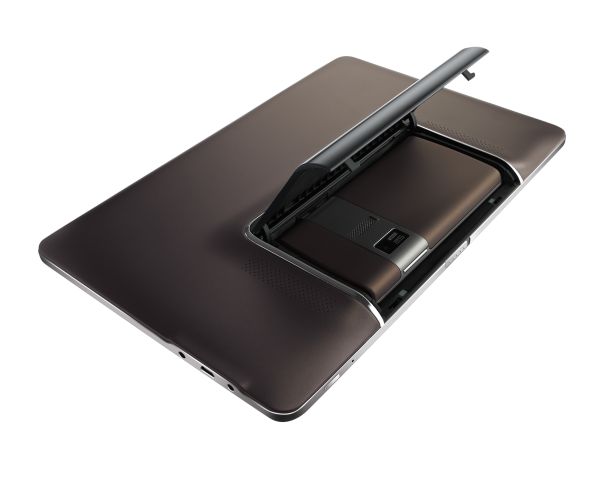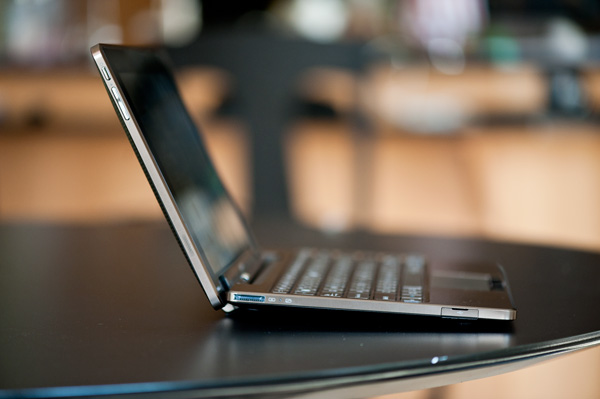The Ultrabook: Meet the New Thin and Light Intel Notebook
by Anand Lal Shimpi on May 31, 2011 12:01 AM EST- Posted in
- Laptops
- CPUs
- Intel
- Atom
- Haswell
- Computex 2011
- Trade Shows
- Ultrabook
Convergence and the Changing PC Landscape
It's too cliché to proclaim netbooks are dead. Perhaps the appropriate phrase is netbooks are no longer interesting to write about, but they do have a roadmap going forward. For years we heard about convergence in the PC and consumer electronics space. Our TVs, set top boxes and video players were all supposed to get more intelligent. Last year we saw the first real fruits of those efforts with the introduction of Google TV and devices like the Boxee Box. Convergence has finally reached mainstream, but the process isn't over yet.
The smartphone revolution is the beginning of a much larger convergence. A melding of computing devices, convergence between the smartphone and tablet, or the tablet and notebook PC. As is typically the case of any convergence process, this one doesn't have a clear end nor does it have a clear roadmap. Along the way there will be many attempts and likely more failures than successes until we meet the handful of devices and strategies that really make sense.
The smartphone will become even more PC-like and the tablet will become even more notebook-like. But where does that leave PCs? They too must evolve and play their role in this process of convergence, after all it will be PC technologies that ultimately drive the convergence (from the example earlier, is it any surprise that both Google TV and Boxee Box feature very PC-like processors running Linux based OSes?).
How does the PC evolve? Part of it is a change in software. Traditional desktop OSes won't go away, but they must incorporate the advantages and innovations brought by the players in the smartphone/tablet markets. Apple is at the forefront of much of this revolution and the next version of Mac OS X already starts to look more like iOS with its app store, app launcher and iOS-like full screen modes. Microsoft is rumored to be preparing a very tablet friendly UI that will layer upon Windows 8, which itself will span everything from tablets (and smartphones?) to desktops.
As we've learned in the past, software enables hardware and hardware enables software. The PC's changing role in the future also requires some new thought about hardware design and what sort of decisions microprocessor manufacturers are going to make going forward. We've already seen hints of this from both AMD and Intel. The two companies no longer make discrete CPUs but rather complete SoCs, similar to what you'd find in a smartphone just on a much larger scale. Like I said before, the PC will adopt the learnings of the smartphone and tablet industries as it evolves.
Today Intel is announcing the first step in that evolution, an announcement that we actually first heard about from another company a year ago.
When Apple introduced the 2010 MacBook Air, Steve Jobs called it a preview of the future of the MacBook lineup. The subsequent MacBook Pro release looked pretty traditional so the messaging may have been a bit premature. I believe what Jobs was referring to was the move toward thinner, lighter and SSD based notebooks across the board. Intel's announcement today puts that future on a roadmap, and the device is called the Ultrabook.













33 Comments
View All Comments
soydeedo - Tuesday, May 31, 2011 - link
Haha, you super sleuth, you. Thanks for the help. =)I actually thought that might be it because of the giant hinge connection/protrusion, but when I went on Google's image search looking for profile pics, nothing really caught my eye. It's a shame, though - I was hoping there was a fully fledged notebook that looked like that. It looks great from that angle anyhow.
duploxxx - Tuesday, May 31, 2011 - link
The final requirement is all Ultrabooks must be sold at mainstream price points, which Intel calls sub-$1000.Intel estimates that by the end of next year 40% of consumer notebooks will be Ultrabooks. Given the desirable set of features and reasonable price point, I can see that happening.
With that pricepoint? your joking right? the share will be about 1-2% some geeks that want to show off on an airport or tradeshow. For that price i buy a decent tablet and a notebook. They will only be able to meat there perf goals in 2013, competition isn't idle in that area.
7x GPU perf means HD3000 like if they calculate from atom based right now, that ain't magic either :), that will just be brazos perf in early 2012 :).
A5 - Tuesday, May 31, 2011 - link
Apple has reached 5+% of the notebook market selling almost exclusively $1000+ products.If I were spending the same amount of money either way, I'd rather have a super-thin notebook than a tablet + a "normal" laptop.
Dribble - Tuesday, May 31, 2011 - link
Got to agree. It's just a macbook air for windows with a different name. The macbook air for mac hasn't sold that well, and that's got all the apple fanboys that should love this sort of thing. The windows market is going to be substantially smaller - haven't other companies already tried this sort of thing?Now if it was $400 they'd sell plenty but it's not so I don't see how it'll ever be more then a tiny niche market.
name99 - Tuesday, May 31, 2011 - link
"The macbook air for mac hasn't sold that well, "And you know this based on the scientific technique of pulling a number out of your ass?
COMMON SENSE would tell us that the product is doing well, given that Apple broadened the line from one to two different models. But we can do more than that, we can look at the numbers.
Q4 2010 Apple sold 1.1 million macbook airs. How does that compare?
In the same period, Apple sold a total of 2.9 million notebooks.
I'd say that's doing pretty well.
jjj - Tuesday, May 31, 2011 - link
" I fully expect Ivy Bridge to target relatively similar TDPs as Sandy Bridge"Is that just an assumption or any solid info? The combination of smaller process and FinFET might allow them to play a bit with perf,power consumption and dies size.
TEAMSWITCHER - Tuesday, May 31, 2011 - link
I am suspicious about this statement well. The big TDP drop should happen with Ivy Bridge and its process change. Haswell, using the same process, will also have a much lower TDP. If not, I fear that the ultra book will get to market too late to counter the growing onslaught of ARM tablet.Khato - Tuesday, May 31, 2011 - link
Here's to hoping that they can actually bring it to fruition. There might be a decent chance of it happening, since I'd bet that Intel is basically taking their learnings from trying to get into the phone and tablet market and applying them to a notebook platform. After all, why can't the same basic tricks used in an atom smartphone be applied to a sandy/ivy bridge laptop? Especially since they could now bring 4G mobile connectivity into the platform the same way they brought wireless into the mainstream with centrino. There's some pretty awesome potential, that's for sure.Calabros - Tuesday, May 31, 2011 - link
at the middle of 2012 ULV IvyBridge (22nm) will be far better in performance/watt ratio than high end Saltwell Atom (yet 32nm).. and its exactly the gap AMD will fillA5 - Tuesday, May 31, 2011 - link
With what? They haven't said anything about updates to Llano for that timeframe.